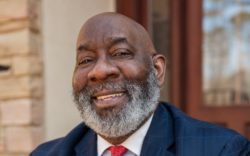Photo Credit: Blake Aued
From left, BikeAthens Administrator Tyler Dewey, Georgia Bikes Executive Director Brent Buice, prosecutor Ashley Ivy, Dale Bowman, an unknown friend of Emily Bowman’s, District Attorney Ken Mauldin, Commissioner Mike Hamby and Harris Blackwood, director of the Governor’s Office of Highway Safety.
The Athens road where an Acworth college student on foot suffered severe brain injuries in a hit-and-run is one of the 18 most dangerous roads for pedestrians in Georgia, according to a University of Georgia traffic researcher.
At a Governor’s Office of Highway Safety press conference this afternoon on bicycle safety, James Barlament highlighted the Oak/Oconee/Lexington corridor between Peter Street and Barnett Shoals Road as “a high priority area for improvement of pedestrian facilities in the state.”
Oak Street near Carr’s Hill is where William Wilson Heaton, 22, of Cartersville, after a night of drinking downtown, hit Emily Bowman as she walked along the side of the road early one February morning, according to police. Bowman recently suffered a setback in her recovery; her release date from the hospital is May 29, according to her father, Dale, who attended the press conference.
Barlament’s job is “locating high-crash geographical locations where more can be done to improve safety for both bicyclists and pedestrians.”
Although no cyclist has been killed in Athens since 2010, there have been several serious collisions that could have led to fatalities, in addition to Bowman’s, according to Barlament. Grace Byrne (who, more fortunately, graduated from Clarke Central High School last week, though she is still not fully recovered) was hit crossing Milledge Avenue earlier this year. And an allegedly drunk driver hit Stacey-Marie Piotrowski on her bike on Talmadge Drive in December.
Other areas Barlament identified as dangerous for pedestrians and cyclists include:
• Prince Avenue between Oglethorpe Avenue and Pulaski Street (which will not be the subject of a town hall meeting tonight).
• College Station Road from the intramural fields to Barnett Shoals Road.
• the entire University of Georgia campus, but especially the Baxter Street-Lumpkin Street intersection near the Tate Center.
Eighty percent of the bike-car collisions on campus were the fault of the motorist, and in 50 percent of them, a car turning right hit a cyclist riding parallel in a bike lane. Inexperience is a factor, and so are speed and topography, as 70 percent of those wrecks happened while going downhill.
BikeAthens Executive Director Tyler Dewey and Georgia Bikes Executive Director Brent Buice advocated for more infrastructure. The No. 1 reason people don’t bike is they don’t feel safe, bike lanes will make them feel safe, and more bikes on the road creates a safer environment for both bikes and cars, Buice said. Dewey cited New York City statistics showing that, when ridership doubles, the number of accidents decreases by a third.
“There is a definite safety in numbers effect as the number of cyclists increases in a town,” Dewey said.
Commissioner Mike Hamby, filling in for an out-of-town Mayor Nancy Denson, highlighted what Athens-Clarke County is already doing to improve bike safety: implementing a Complete Streets policy that gives bicyclists and pedestrians the same weight as cars, restriping roads with bike lanes (though not Prince Avenue), building median refuges and adding countdown timers to intersections, with a focus on students through the Safe Routes to School program. But he acknowledged that more needs to be done.
“We do need to improve bicycle safety here in town, and we’ve got a mayor and commission that’s committed to doing that,” Hamby said.
This post has been corrected to update Grace Byrne’s health status and Tyler Dewey’s title with BikeAthens.
Like what you just read? Support Flagpole by making a donation today. Every dollar you give helps fund our ongoing mission to provide Athens with quality, independent journalism.










